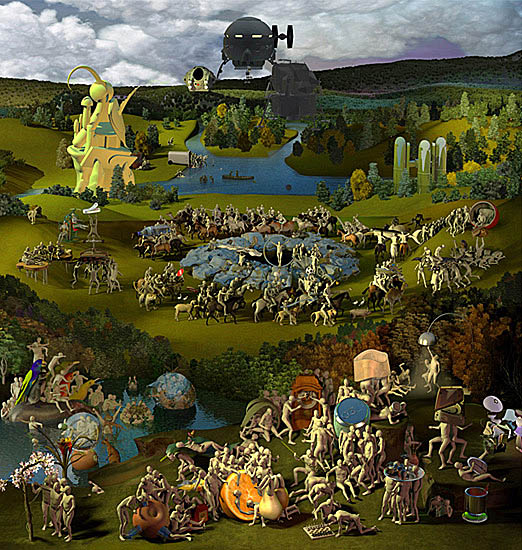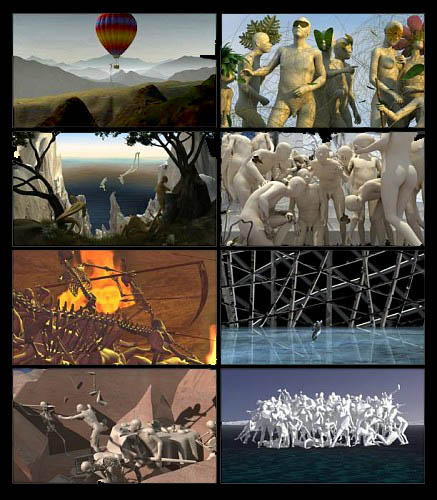
Miao Xiaochun, 2009, photo geraldnestler
Miao Xiaochun
缪 哓 春
Digital Photography *1964 Wuxi, Jiangsu, lives in Beijing

Miao
Xiaochun, 2009, photo geraldnestler
Miao Xiaochun was born in Wuxi, Jiangsu Province. In 1986 he received his bachelor’s degree from Nanjing University. In 1989 Miao graduated from the Central Academy of Fine Arts in Beijing, China and from Kassel Academy of Fine Arts in Germany in 1999 with two master degrees. He is teaching Art Photography and Digital Media at the Central Academy of Fine Arts in Beijing.
Miao is obsessed with Western visions of the apocalyptic end of the world. He choses famous depictions of this event and remodels them with computer techniques, the larger the better.
“The Last Judgment in
Cyberspace”
2006

“Last
Judgement in Cyberspace”, 2006, B&W-print, 418 x 360 cm
photo
walshgallery
One of the first examples was his “Last Judgement in Cyberspace” (2006), where he appropriated Michelangelo’s Sistine Chapel fresco and built a virtual model of the “Last Judgement” by replacing each of the 400 figures in the original with figures modelled on his own naked body using 3D modelling techniques. The figures are placed in corresponding poses and positions of the original painting. He also created different versions from varying viewpoints, such as looking down or from the side, to model the spatial arrangement of the figures in the original fresco. Miao positions the audience as saints looking down from above or ‘the damned’ looking up from below.
“Microcosm”
2008

“Mïcrocosm”,
9 panels, C-prints,286 cm high, 2008
photo arthag
His next large experiment Miao based on Hieronymus Bosch's triptych: the 'Garden of Earthly Delights'. This panting is a surprising subject for such a procedure: only the right wing of the Bosch triptych is related to some kind of armageddon, the center panel is a celebration of earthly love in a neoplatonic setting.

“Microcosm”
Central Panel, C-print, 300 x 286 cm, 2008
photo ausintunggallery
To find it populated by naked male couples, including the two transparent seed bubbles, is mildly estranging. Miao also misunderstands the neoplatonic theme of the upper half of Bosch's original. The threatening helicopter landing in paradise, is not sufficient to give an apocalyptic air to the this celebrated Western painting.
|
|
|

The
Treeman of Bosch's “Terra Nostra” has acquired a laptop
with
which he controls a Black Hawk model-plane to spy on Miao's
world
Panel 8 of “Microcosm”, C-print, 273 x 360 cm, 2008,
photo
artnet
“Beijing Hand Scroll”
2007-2009
|
|
|
Two sections of “Beijing Hand
Scroll”, 2007-2009, Digital Ink Painting Mounted on Silk, 35 x 374
cm overall
photo Carol
Carter
Hand scrolls have a long history in
traditonal Chinese art. Having become rather efficient in computer
graphics – Miao now has a number of computer technicians who assist
him – he tried to produce such a scroll of little known corners of
Beijing.
Miao describes the procedure:
“We first took a
photo with a 360 degree camera, which creates very long images. Then
we scanned and reworked them on the computer. The final product looks
like a traditional painting but in fact everything was created on the
computer. In ancient times they used brushes and ink to do their
painting, today we use a mouse and a computer. These are the brush
and ink of our time.”
chinaphotoeducation
"Restart"
2008-2011

Stills
from “Restart”, computer generated 3-D animated video, 14.2 min,
2008-2011
photo cafa.com.cn
In 2008 Miao began creating his own view of Armageddon and the death and rebirth of mankind in form of an elaborate DVD video. It was first shown at the Ludwig Museum in Koblenz, Germany, in 2011.
“RESTART” begins with scenes
from Pieter Bruegel’s “The Triumph of Death”, but they are
recast completely for his purpose. A man on Daliesque skeleton stilts
(1) crosses an idyllic Kasper David Friedich landscape (2). The world
is burning (3), then crumbles burying its inhabitants (4).
At this
moment a goat-headed goddess (Hathor?) appears with an
entourage of lascivious females (5), spinning the men into a
spiderweb. It rains black flower petals (5). The men take refuge in
Raphaels “School of Athens”, which soon falls apart and so do the
men, one by one. Out of the general chaos emerges a single skater (7)
and two metal ladders on which two babies climb skywards. The end
finds a group of men on an ice float in a beautifully abstract
antarctic seascape (8).
An extensive review by Ursula Panhans-Bühler in English and a link to the full video is found at cafa.com.cn.
The trouble is that, because of the
slow internet connection to Beijing, it takes 1-2 hrs to download the
video of 14.2 min! - I sugest to set up the download process at some
time when the computer is not in use or will shut down and see the
movie when it has loaded. Once downloaded the video runs perfectly
well in full-screen mode. The music is Beethoven's ”Missa
Solemnis”.
I highly recommend seeing this interesting video.
In case my link does not work on
your computer, here is the full URL:
http://en.cafa.com.cn/restart-by-miao-xiaochun-1422-3d-computer-animation-2010.html
The Apocalypse in
China?
Why this
intense preoccupation with Western apocalyptic themes? Without going
into a deep philosophical analysis we should remember that the
Apocalypse has for a thousand years, from St. John to Bosch been a
preeminent subject of Western art. It only lost its fascination
during the Enlightenment – and “witchcraft”, “devil worship”,
and similar superstions occasionally continue to disturb people in
our times.
Because of the rapid cultural changes, China is just
now going through a state of intense anxiety that the “new
modernisations”, their Renaissance could collapse any day. And
China does not have a religeous or philosophical tradition that could
deal with that emotional fear. Confucius in the Analects
(3.12; 6.20; 11.11), Lunyun,
論
語,
is reported to have once said,
“Ï know nothing about Death – and I leave the Thereafter
(Heaven) to the priests,” - a philosophy that influenced Leibniz,
Voltaire and other Western thinkers of the 18th-cent. Enlightenment.
- To Buddhism such transcendental questions are “virtual”
figments of the mind that would dissolve in Nothingness once someone
reached the State of Nirvana. - The Tibetan Mahayana simply converted
the fearsom Bön apparitions into protectors of the Dharma.